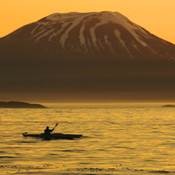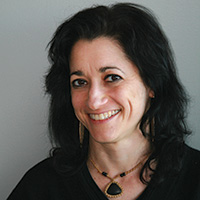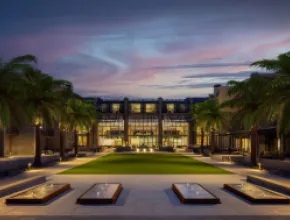In Alaska, the numbers tell the story. The “Land of the Midnight Sun” spans more than 580,000 square miles, covering twice the size of Texas, and features 119 state parks, more than half the glaciers in the world and infinite outdoor activities. Visitors can choose from adventures like sea kayaking, wildlife viewing and ice climbing, in addition to more-cultural excursions like exploring the state’s history and art museums or visiting an Alaska Native village.
Despite its enticing remote flavor, Alaska is well connected by air and sea, and touts a unique blend of rustic rural hideaways, urban hotels and world-class amenities that make it an alluring destination for groups to gather.
Anchorage
Anchorage sprang up in 1914 as a railroad construction camp on Ship Creek. Though it now ranks as the state’s largest city, nature reigns supreme.
Anchorage sits between the Chugach National Forest and the shores of Cook Inlet and offers close proximity to adventures such as downhill and cross-country skiing, snowboarding, dog sledding, ice fishing, and snowshoeing. In summer, groups can cruise the Prince William Sound or take a flight-seeing trip over ice fields and glaciers.
Despite all its assets, marketing Anchorage to groups poses some challenges, according to Julie Saupe, president and CEO of the Anchorage CVB.
“They think Alaska is far away,” she says. “Once we get their attention it’s not a difficult sell, especially if we get them here or they have held a meeting here before. Our new campaign is ‘Anchorage Big Wild Life.’ That sums up the attitude and environment.”
Along with the new campaign, an interactive website was launched, www.bigwildlife.net, highlighting the abundance of activities available year-round.
One project that will make Anchorage an easier sell is the upcoming Dena’ina Center, which is being marketed as the centerpiece of the new downtown Civic and Convention District. The district is within easy walking distance of more than 3,000 hotel rooms as well as museums and stores, and includes the William A. Egan Civic and Convention Center and the Alaska Center for the Performing Arts.
When the Dena’ina Center is completed this fall, it will total 215,000 square feet, including a 25,350-square-foot ballroom, a 50,000-square-foot exhibit hall for up to 274 trade show booths, 15,000 square feet of prefunction lobby space, and an outdoor terrace for up to 900 people. The flexible space will also be able to offer more than 10,000 square feet of meeting rooms.
“The neat thing that is coming on-line is the 50,000-square-foot exhibit hall,” Saupe says. “That is a size we couldn’t sell before. There are a lot of meetings with a trade show component, and we are now open to those meetings.”
Other changes in the district include $3 million in upgrades to the existing convention center and the expansion of the Anchorage Museum of History and Art, with 70,000 square feet of new space debuting in 2010.
Also under construction are 300 rooms in Anchorage. Ground was broken late last year for a 166-room Crowne Plaza hotel that will offer 2,800 square feet of meeting space. The property is scheduled to open in early 2009. A 169-room Embassy Suites and a 166-room Holiday Inn are slated to open by the end of this year.
Additionally, Alyeska Resort in nearby Girdwood recently completed a $4 million facelift.
Other meetings-friendly hotels include the Hilton Anchorage, the Hotel Captain Cook, the Anchorage Marriott Downtown, and the Sheraton Anchorage.
Off-site, the Alaska Native Heritage Center offers a number of group programs.
Just south of Anchorage lies the Kenai Peninsula, popular for whale watching and wildlife viewing, among other activities. The Holiday Inn Express Seward Harbor is undergoing an expansion that is scheduled for completion this spring. The project will add nine guest rooms, bringing the total to 91, and two meeting rooms.
Meetings can also be held on the Alaska Railroad, offering luxury double-deck railcars.
Fairbanks
Heading into the interior, Fairbanks is the gateway to the Brooks Range and Arctic Coastal Plain and to native communities such as Fort Yukon and Anaktuvuk Pass. The Arctic National Wildlife Refuge is easily accessible by small plane, and Fairbanks offers prime viewing of the northern lights.
In the city, visitors can experience the state’s history at Pioneer Park or take a ride on the Riverboat Discovery.
“Fairbanks is good for people who want the amenities of a city while being on the edge of the wilderness where the Alaska lifestyle is still very much retained,” says Deb Hickok, president and CEO of the Fairbanks CVB. “We particularly love to sell groups in some of the winter months, for example in March, when we gain seven minutes of daylight a day and we have world ice art championships.”
Fairbanks’ main meetings venue is the Carlson Center, which offers three meeting rooms totaling 10,000 square feet and an arena with 35,000 square feet of space. The recently expanded, 400-room Westmark Fairbanks Hotel and Conference Center and the Fairbanks Princess Riverside Lodge also feature meeting space.
There are other plans for expansion.
“We are doing a feasibility study this year to see about getting a convention center,” Hickok says. “We would have a space devoted to conventions; the facility we have now is also devoted to athletics.”
If the study moves forward, Hickok says Fairbanks could expand its marketing to the Pacific Northwest in particular. But the study will likely take at least a year, she estimates.
Another upcoming project is the Morris Thompson Cultural and Visitor Center, slated to open in August. The center will eventually feature an exhibit on the state’s natural history and Alaska Native history of the interior and will include artisan workshops, presentations by elders, live performances, and narrative talks. The exhibits are not scheduled to open until May 2009, but the building can begin hosting receptions sooner.
On the hotel front, construction of the 106-room Holiday Inn Express Fairbanks is under way and set to open this summer. The 115-room Alpine Lodge is expanding its meeting space to accommodate up to 400 theater style and will be opening a new restaurant.
For off-site venues, the University of Alaska Museum of the North is a favorite option, while popular group excursions include tours to Denali National Park and flights over the Arctic Circle and to interior villages.
In Denali National Park, Camp Denali, McKinley Village Lodge and McKinley Chalet Resort will all undergo major renovations in 2008.
Juneau
Alaska’s capital boasts the most accessible glaciers in the state. Juneau sits just 60 miles from the 3.3 million-acre Glacier Bay, the world’s largest protected marine sanctuary. Juneau is also within striking distance of the world’s largest concentration of brown bears on Admiralty Island, and it is home to more than 20,000 bald eagles, just 10,000 fewer than its human population.
“Because of our natural environment, we are a natural draw,” says Lorene Palmer, president and CEO of the Juneau CVB.
The city attracts environmental groups, preservation societies and marine science groups, as well as Alaska Native organizations. With between 800 and 900 rooms, the optimum group size is up to 600 people.
The city’s Centennial Hall Convention Center is the main meeting venue, with 20,000 square feet of space. Other options include the Mt. Roberts Tramway facility and Juneau Douglas City Museum.
Group activities include flight-seeing over the Juneau Icefield, dogsledding and trekking on the Mendenhall Glacier. There are two new rainforest zip lines, one in the historic Treadwell mining area and another at Eagle Crest Ski area. Alaska Canopy Adventures and Alaska Zipline Adventures offer the tours.
On the ground, Juneau has a new cooking school, Chez Alaska, which offers programs on cooking Alaskan food as well as team-building opportunities.
Matanuska-Susitna
The 23,000-square-mile Matanuska-Susitna (Mat-Su) Valley is quintessential Alaska, with its small-town flavor and big-time attractions. Mat-Su features more than 2,000 miles of trails and close access to what locals call Denali, or Mt. McKinley.
“One of the comments we hear from people is that they have an image of what Alaska will look like and be like,” says Tammy Bruce, tourism director of the Mat-Su Valley CVB. “If they go to a large city they can be a little disappointed. When they come to our area, that’s where their expectations are met.”
Mat-Su excels at smaller group meetings of 100 to 150 attendees, as well as corporate getaways. A number of fly-in and fly-out lodges, such as Riversong Lodge, offer exclusive cabins in a wilderness setting.
Bruce also stresses that the valley is a value destination compared to other parts of Alaska.
“The Dena’ina Convention Center opening in Anchorage may have a positive impact on our area,” Bruce says. “We may be able to capture some of the smaller group meetings. It may be more affordable to come here, and they also can come for pre- and post-meeting leisure travel.”
The valley has three main towns, the largest of which is Wasilla, home of the Iditarod Trail Sled Dog Race and the Tesoro Iron-Dog 2000, the world’s longest snowmobile race.
It features the Wasilla Multi-Use Sports Complex, which offers separate meeting rooms and can host trade shows. Other options include the Best Western Lake Lucille Inn and space at the Museum of Alaska Transportation & Industry. The Meier Lake Conference and Retreat Center just outside Wasilla is located on a private lake and offers options for hiking, canoeing and team-building activities.
Talkeetna, with its frontier village feel, also offers one of the state’s best views of Denali from the Talkeetna Alaska Lodge. Another meetings option is the McKinley Princess Wilderness Lodge, with 460 rooms.
The town of Palmer, the seat of the Mat-Su government, offers white-water rafting on the Chickaloon River and visits to the Matanuska Glacier and Knik Glacier. Palmer Depot has space for groups, while the nearby Sheep Mountain Lodge, which expanded in 2006, can host board meetings.
According to Bruce, there is proposed development in the Hatcher Pass region between Palmer and Wasilla.
“It’s a recreational playground,” Bruce says. “If developed, it will be a great area for meeting planners to do retreats and downhill or cross-country skiing.”
Valdez
Adventure-seekers need look no further than Valdez, home to five glaciers that can be accessed by cruising, flying, walking, or driving. Glacier rappelling is possible, as is heli-skiing in winter. The waters near Valdez abound with sea otters, porpoises, and humpback and orca whales.
“Our scenery—the pristine atmosphere we have here—is the draw,” says David Peterson, executive director of the Valdez CVB. “We offer an opportunity to get away without having to get away too far.”
Groups can charter sport fishing boats and organize sea kayaking tours to the Columbia Glacier, among other activities. The most popular options are day cruises from companies like Stan Stephens Glacier & Wildlife Cruises.
The Valdez Convention and Civic Center offers 18,000 square feet of flexible space, including a ballroom that seats 500 people. The center recently expanded its kitchen, allowing for off-site as well as on-site catering.
In summer, the capacity for groups in Valdez tops off at 500, while the city can accommodate nearly double that amount in spring and fall.
Meeting spaces include the Best Western–Valdez Harbor Inn, which has a small conference room, as well as the Mountain Sky Hotel, formerly the Aspen Hotel. The new ownership is planning renovations.
Ketchikan
Just a 90-minute flight from Seattle, part of Ketchikan’s charm lies in its accessibility.
“Groups spend a lot less time traveling and more time at the destination,” says Patti Mackey, executive director of the Ketchikan Visitors Bureau. “Another strong selling point—we’re on the Inside Passage. Because we’re a cruise destination we have a strong complement of activities to enjoy pre or post conference.”
Options include fishing charters and harbor cruises to Misty Fjords National Monument. There are also opportunities for kayaking and a ropes challenge course for team building.
Ketchikan is rich in Alaska Native culture, with the largest collection of totem poles in the world. Groups can experience the culture at the Saxman Native Village, where visitors see totems being carved, native dance performances and films. There is also a clan house on the site for community or group events. The Totem Heritage Center offers another attraction for groups.
The city is in the process of upgrading and beautifying its waterfront area.
Group facilities in Ketchikan include the Ted Ferry Civic Center, with a capacity for 500 people, and meetings-ready hotels such as Salmon Falls Lodge, recently under new ownership, as well as the Cape Fox Lodge.
Sitka
Protected bays and mountain views combine with native Tlingit culture and Russian history in Sitka.
“We’re off the beaten path,” says Sandy Lorrigan, executive director of the Sitka CVB. “Something may take a little planning here, but we’re also one of the most scenic places in Alaska. We have history, wildlife, islands surrounding us. It all comes together in a small location, which makes it unique.”
Harrigan Centennial Hall and the Westmark Sitka offer meeting space.
Sitka is also preparing for the debut early this year of its new Performing Arts Center, which will seat 650 people and include a large reception area. The center will host Sitka’s Jazzfest.
Additionally, the Alaska Raptor Center can host up to 125, and the Southeast Alaska Indian Cultural Center is also open to groups.
For More Info
Alaska Travel Industry Association 800.862.5275 www.travelalaska.com
Anchorage CVB 907.276.4118 www.anchorage.net
Fairbanks CVB 907.457.3282 www.explorefairbanks.com
Juneau CVB 907.586.1737 www.traveljuneau.com
Matanuska–Susitna CVB 907.746.5000 www.alaskavisit.com
Sitka CVB 907.747.5940 www.sitka.org
Valdez CVB 907.835.2984 www.valdezalaska.org







